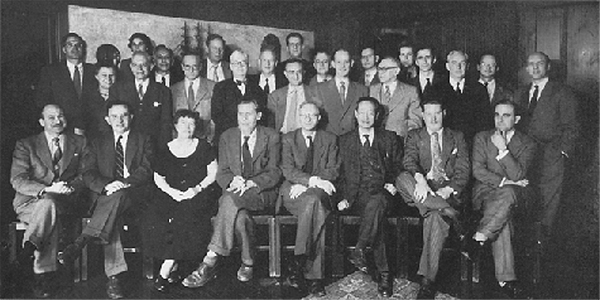
 |
| American Society for Cybernetics |
A great deal of learning underpins Pynchon’s fiction, and if you’re not careful, reading him can pique your curiosity about some of his references and riffs and send you down endless rabbit trails. (And it’s all on the internet now! And Pynchon wrote almost all these immensely learned books before the internet! Dude must have spent years in libraries, like scholars used to back in the old days.)
When SHROUD tells Benny, “Me and SHOCK are what you and everybody will be someday,” it’s talking about entropy. Pynchon wrote a story called “Entropy” and he seems fascinated with the concept: I suspect that at least half of the undergraduate papers about Pynchon ever written have taken entropy as their theme. In the long introduction to Slow Learner that I’ve already mentioned a time or two he acknowledges this interest and mentions that he learned a lot about entropy by reading Norbert Wiener’s book The Human Use of Human Beings, so I took some time out from reading Pynchon to read Wiener.
It’s an interesting book in some ways, a semi-popular rewriting of his earlier book Cybernetics and a celebration of all the problem-solving the application of cybernetics will achieve. It’s rambling, though, and burdened by a woefully inadequate account of language. For Wiener, language is a matter of communication, communication is a matter of messaging, messaging is a matter of information, and information (as Wiener learned from his collaborations with the great Claude Shannon) is a matter of bits. So for Wiener language is simply the transfer of bits. I think Pynchon, whatever debt he may have owed to Wiener, resists this model of language — but more about that in later posts.
Anyway, it seems clear to me that the primary illumination Wiener offers Pynchon may be found, in condensed form, in this passage:
Messages are themselves a form of pattern and organization. Indeed, it is possible to treat sets of messages as having an entropy like sets of states of the external world. Just as entropy is a measure of disorganization, the information carried by a set of messages is a measure of organization. In fact, it is possible to interpret the information carried by a message as essentially the negative of its entropy, and the negative logarithm of its probability. That is, the more probable the message, the less information it gives. Cliches, for example, are less illuminating than great poems.
(If only Wiener had thought through the implications of that last sentence!) The key point here is that entropy comes in two varieties: thermodynamic and informational. And I think it’s Wiener’s intuition that the world of communication and the “external world” are alike governed by the relationship between organization and disorganization that leads him to conceive of cybernetics as a universal science of control. Thus:
Since the end of World War II, I have been working on the many ramifications of the theory of messages. Besides the electrical engineering theory of the transmission of messages, there is a larger field which includes not only the study of language but the study of messages as a means of controlling machinery and society, the development of computing machines and other such automata, certain reflections upon psychology and the nervous system, and a tentative new theory of scientific method.
I find this ambition very interesting, and couldn’t help trotting down some of those rabbit trails. For instance, Wiener praises very highly a book called Design for a Brain by an English psychiatrist called Ross Ashby, and it turns out you can download that book from the Internet Archive. So I did, and read that too, and it’s fascinating to discover that Ashby is one of the first people to conceive of the brain as a kind of computing machine — and to describe the kind of behavior we call “conscious” as something that emerges from a relatively small set of rules, so that the brain is mechanistic but also adaptable. So Ashby anticipates a good deal of later reflection on emergent behavior as well as the deeply misleading notion that brains are computers. You can even see the New Atheists’ denial of free will embryonically present in Ashby. (Curiously, Ashby says he believes in consciousness and may even believe in free will, but he thinks such hypotheses unnecessary to explain the design and functioning of the human brain, as Laplace in explaining celestial mechanics had no need for the hypothesis of God’s existence.)
It’s very important to note that — and this is a topic I have written about before — the ambitions of cybernetics arise from a series of solutions to problems of warfare during World War II, from the encrypting of secret messages to the aiming of artillery. Those who had acquired the know-how to win the war claimed on that ground the privilege of directing the postwar world. The details of these ambitions, of their successes and failures, are traced in a truly remarkable book by Ronald R. Kline, The Cybernetics Moment. Here’s a passage from the Introduction to that book in which Kline describes a photograph of most of the key figures in cybernetics that features the anthropologist Margaret Mead front and center:
It might seem odd to today’s readers that Margaret Mead sat in a prominent place at the now famous Macy conferences and that she would be remembered a half century later as one of the founders of cybernetics. Why would a world-renowned anthropologist with no expertise or apparent interest in mathematics, engineering, and neuroscience attend all ten meetings, recruit social scientists for the meetings, and undertake the tedious job of editing the proceedings? When the group was first organized, Mead shared the enthusiasm of her husband Gregory Bateson that cybernetics would bring the rigor of the physical sciences to the social sciences. They thought cybernetic models could realistically explain the behavior of humans and society because they contained the information feedback loops that existed in all organisms. This belief was reflected in the original title of the meetings: “Conference on Feedback Mechanisms and Circular Causal Systems in Biology and the Social Sciences.” Everything that Bateson wrote after the Macy conferences – on a wide range of subjects from psychiatry to animal learning – testified to his belief in the power of cybernetics to transform human ways of knowing. The conferences convinced Mead that the universal language of cybernetics might be able to bridge disciplinary boundaries in the social sciences. The presence of Mead and Bateson among the mathematicians, natural scientists, and engineers in the group photo symbolizes the interdisciplinary allure of cybernetics and information theory….
In the 1950s, scientists were excited that Wiener and Shannon had defined the amount of information transmitted in communication systems with a formula mathematically equivalent to entropy (a measure of the degradation of energy). Defining information in terms of one of the pillars of physics convinced many researchers that information theory could bridge the physical, biological, and social sciences. The allure of cybernetics rested on its promise to model mathematically the purposeful behavior of all organisms, as well as inanimate systems. Because cybernetics included information theory in its purview, its proponents thought it was more universal then Shannon’s theory, that it applied to all fields of knowledge.
This enthusiasm led scientists, engineers, journalists, and other writers in the United States to adopt these concepts and metaphors to an extent that is still evident today…. The traces of cybernetics and information theory thus permeate the sciences, technology, and culture of our daily lives.
Emphases mine. By the way, some elements of this history have featured in writings here at The New Atlantis: see essays and posts by Adam Keiper, Charles T. Rubin, and David Frantz, among others.
So, after this long detour, back to Pynchon. I think Pynchon’s early fiction demonstrates a complicated and ambivalent response to the claims of cybernetics and information theory. There’s no doubt that he owes a lot to his reading of these thinkers, and indeed I would argue that you could see V. and The Crying of Lot 49 as a kind of cybernetic diptych, with the former focusing on entropy as a concept in thermodynamics and the latter on entropy as a concept in information theory.
And I am also inclined to see Pynchon’s recurrent interest in marginal and chaotic figures, tricksters and buffoons, as an implicit critique of the mechanistic models of thinking and language articulated by Ashby and Wiener. The Whole Sick Crew in V. are indeed kinda sick — as one marginal member of the group rightly says, “there is no one of us you can point to and call well” — but they are also exemplary of what Michael Bakhtin called the human surplus, that which is left over after the scientists and mechanists have made all their calculations, that which the calculations of cybernetics can never quite account for. In this light, Pynchon’s praise of Kerouac’s On the Road as one of the great American novels makes a lot of sense. Pynchon stands at the intersection of Kerouac and Wiener, the Beats and the Cyberneticists.


How can we get the UT Austin iSchool to invite you for a guest lecture? 🙂
Andrew, I'm pretty sure nothing on God's green earth could make that happen.
Well, we can dream. I do think that you would find quite a few people there interested in your project of the technological history of modernity, even if your vision doesn't quite match up with the school's institutional raison d'etre.